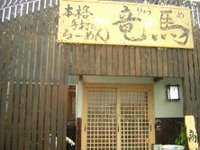:::::::::::::::::::::::::::::::::::::::::::::::::::::::::::::::::::::::::::::::::::::::::::::::::::::
ryuuma 竜馬, 龍馬 : "splendid horse"
非常にすぐれた馬。駿馬。
りゅうま。りょうめ。りょうば。たつのうま。
ryuuma, ryuume, ryuuba, tatsu no uma
Dragon-Horse at a Lotus Lake temple, Taiwan

© Hakym at flickr
:::::::::::::::::::::::::::::::::::::::::::::::::::::::::::::::::::::::::::::::::::::::::::::::::::::
"The dragon by nature is yin, and there is nothing with which it will not mingle.
If it consorts with an ox it will bear a qilin (kirin 麒麟) ;
cross it with a pig and it will bear an elephant (he uses the archaic term "kisa" 象 きさ),
cross it with a horse and it will bear a dragon-steed (ryuume 竜馬)."
. Takizawa Bakin 滝沢馬琴 (1767 - 1848) .
Nanso Satomi Hakkenden
(The Satomi Clan and the Eight Dogs)
:::::::::::::::::::::::::::::::::::::::::::::::::::::::::::::::::::::::::::::::::::::::::::::::::::::
Dragon Horse
(quote from the" Serene Dragon")
Region: China
Time Period: 2nd Century BC
References in Literature: None
Sources: Giants, Monsters and Dragons pg 107, Dragons and Dragon Lore
Dragon's body and the front of a horse
Could fly with wings
Was the heavenly messenger of the gods
Revealed Yin and Yang and the balance of the cosmos
Heaven and Earth combined into one being
Horse's body, dragon scales, wings. Is also mentioned with a hug serpent tale
In some pictures, the wings are underdeveloped and feathery, in others, the wings are fully developed
There is an account from 741 AD, cited by Visser
Can walk on water
"If a holy man is on the throne it comes out of the midst of the Ming River carrying a map on its back."
(Source: Dragons and Dragon Lore)
Emperor Muh drove a carriage with 8 winged dragon-horses.
The use of a horse dragon, and it's development, may come in part from the Chinese people's history with horses. The horses would then slowly take on dragon characteristics.
Read a lot more about Dragon Lore:
the serene dragon.net
:::::::::::::::::::::::::::::::::::::::::::::::::::::::::::::::::::::::::::::::::::::::::::::::::::::
Ryuume, the Dragon Horse, is a stone in the Japanese Shogi Game.

Wikipedia about Ryuume (Japanese)
shoogi
:::::::::::::::::::::::::::::::::::::::::::::::::::::::::::::::::::::::::::::::::::::::::::::::::::::

. Dragon Horse Temple 龍馬山 .
. Minamoto no Yoshitsune 源の義経 (1159 - 1189) .
- Introduction -
Shanaoo, Shanaō 遮那王 Shanao (his boyhood name at Kurama)
牛若丸 Ushiwakamaru // Hoogan 判官 Hogan (his court title)
Yoshitsune Temple Gikeiji at Minmaya
「義経寺」(ぎけいじ) 三厩村
Minmaya Village rests at the northern top of the Tsugaru Peninsula and is the closest town to Tappi Saki (Cape of the Flying Dragon). This beautiful little fishing village is nestled tightly between the mountains and the sea and looks out over the Tsugaru Straits to Hokkaido to the north and Shimokita to the east.
The village has a long history and is well known for the Yoshitsune legend from almost 1000 years ago. Yoshitsune Minamoto was a famous general who lived from 1159 to 1189. Yoshitsune's older brother Yoritomo became jealous of Yoshitsune's popularity and strength and ordered him to be killed by his ally Yasuhira Fujiwara. Yoshitsune chose to commit suicide rather than be killed. This apparently took place in Iwate ken in 1189. There are however, a number of legends surrounding his apparent death. Some even go as far to say that he changed his name to Ghengis Khan and united Mongolia.
One legend has it that the person who committed suicide was his vassal, and that Yoshitsune himself ran away to the north. There does seem to be some evidence to support the theory that Yoshitsune did travel north, through Tohoku to Tsugaru then across to Hokkaido and the legend of Minmaya supports this view.
After fleeing from Iwate Ken, Yoshitsune reached Minmaya Mura from where he hoped to cross to Hokkaido, but found it impossible due to rough seas. As he was unable to do anything he sat on a rock and prayed to Kunnanon, the goddess of Mercy. At the end of the third night, a grey haired prophet suddenly appeared and told Yoshitsune that he would be able to cross the sea riding three horses.
In the morning he found the sea as smooth as glass and three Pegasus' in the rock cave. Yoshitusne was then able to cross safely to Hokkaido. The rock cave is called Miya-ishi and is known as the origin of Miumiya, which is the shed of three horses, from which Minmaya gets its name.
A temple dedicated to Yoshitsune sits above the rock from which there are views of Hokkaido and the fishing village below. Every August the Yoshitsune Matsuri is held where his journey is re-enacted in the town.
source: Clare Thompson

Kannon Hall and Yoshitsune Rock
岩の下の洞穴に三頭の龍馬(りゅうば)がつながれていた。
これが「三馬屋→三厩」の地名のいわれだという。
There is also a famous Kannon statue carved by Enku in this temple.
I once visited there and found the area very impressive!

When Enku visited this area, he saw a shining Kannon and later learned about the Yoshitsune legend. So he carved this statue and hid the shining Kannon in its back.
. Enku, the Master Carver 円空 (Enkuu)
. WKD : Genghis Khan and Haiku
:::::::::::::::::::::::::::::::::::::::::::::::::::::::::::::::::::::::::::::::::::::::::::::::::::::
A restaurant called "Ryuume"
行田にあるサッパリ系(佐野ラーメン系)が食べられるお店です。

http://www.geocities.jp/xxsizzxx/tabemono/tara41.html
:::::::::::::::::::::::::::::::::::::::::::::::::::::::::::::::::::::::::::::::::::::::::::::::::::::
There is also a proverb with the Dragon-Steed
竜馬の躓き(りゅうめのつまずき)
ryuume no tsumazuki : the Dragon-Horse stumbles
even a skilled person sometimes makes a mistake
:::::::::::::::::::::::::::::::::::::::::::::::::::::::::::::::::::::::::::::::::::::::::::::::::::::
坂本 龍馬 Sakamoto Ryooma
Sakamoto Ryoma (1834-1867)
:::::::::::::::::::::::::::::::::::::::::::::::::::::::::::::::::::::::::::::::::::::::::::::::::::::
... legends such as Shōtoku’s riding a flying horse ...
This article argues that myths and legends of deadly horse-riding spirits were most likely shaped not by the memory of ancient horse riding armies, but rather by a host of forces that included immigrant deities, natural disasters and plagues from which even rulers were hard pressed to escape.
Horses,Dragons,and Disease in Nara Japan PDF file
Michael Como
:::::::::::::::::::::::::::::::::::::::::::::::::::::::::::::::::::::::::::::::::::::::::::::::::::::
Horse Deities of Japan
Bato Kannon, White horses and Shinto Deities ...
batoo kannon
:::::::::::::::::::::::::::::::::::::::::::::::::::::::::::::::::::::::::::::::::::::::::::::::::::::::::::::::::::::::::::
[ . BACK to DARUMA MUSEUM TOP . ]
[ . BACK to WORLDKIGO . TOP . ]
- #ryume #dragonhorse -
:::::::::::::::::::::::::::::::::::::::::::::::::::::::::::::::::::::::::::::::::::::::::::::::::::::::::::::::::::::::::::








No comments:
Post a Comment